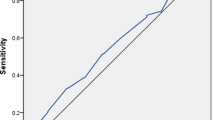Abstract
Purpose
We aimed to illustrate the importance of cystoscopy for the diagnosis and prognosis of bladder pain syndrome (BPS) or interstitial cystitis (IC).
Methods and materials
We designed a 4-year prospective follow-up study. Patients who underwent cystoscopy between May 2011 and July 2021 with a diagnosis of BPS/IC before surgery or positive cystoscopic findings during initial surgery at Peking University People's Hospital were enrolled. Data related to symptom recurrence were obtained through clinic visits and telephone follow-up. We compared the differences in clinical features of BPS/IC subtypes differentiated by cystoscopy and first created clinical predictive nomograms for BPS/IC.
Results
A total of 141 patients were included. There was an 8.51% chance of BPS/IC being misdiagnosed as other diseases or other diseases being misdiagnosed as BPS/IC without cystoscopy. Patients with HIC had higher pain scores and ICPI, higher residual urine volume, lower first-sense-to-void, and maximum cystometric bladder capacities than NHIC. Nomogram Models showed that patients who with higher ICPI, ICSI and lower AMBC have a greater recurrence probability, and lesions in the trigone may indicate a greater likelihood of recurrence than lesions in other bladder walls.
Conclusions
Timely detection of bladder cancer and other diseases using cystoscopy can avoid poor treatment effects. BPS/IC subtypes can be classified according to mucosal changes under cystoscopy. Lesions in the bladder triangle can indicate a higher recurrence risk, which is important in follow-up treatment. We strongly recommend that cystoscopy should be included in the international BPS/IC diagnostic criteria.


Similar content being viewed by others
Data availability
The authors confirm that the data supporting the findings of this study are available within the article or its supplementary materials.
Abbreviations
- AMBC:
-
Maximum bladder capacity under anesthesia
- BPS:
-
Bladder pain syndrome
- CWH:
-
Cystoscopy with hydrodistension
- HIC:
-
Interstitial cystitis with Hunner lesions
- IC:
-
Interstitial cystitis
- ICPI:
-
Interstitial cystitis problem index
- ICSI:
-
Interstitial cystitis symptom index
- NHIC:
-
Interstitial cystitis without Hunner lesions
- OABSS:
-
Overactive bladder symptom score
- PUF:
-
Patient urgency and frequency scale
- SUI:
-
Stress urinary incontinence
- VAS:
-
Visual analog scale
References
Homma Y, Akiyama Y, Tomoe H et al (2020) Clinical guidelines for interstitial cystitis/bladder pain syndrome. Int J Urol 27:578–589. https://doi.org/10.1111/iju.14234
Wein AJ, Hanno PM, Gillenwater JY (1990) Interstitial cystitis: an introduction to the problem. In: Hanno PM, Staskin DR, Krane RJ, Wein AJ (eds) Interstitial Cystitis. Springer, London, pp 3–15
Hanno PM, Landis JR et al (1999) The diagnosis of interstitial cystitis revisited: lessons learned from the national institutes of health interstitial cystitis database study. J Urol 161:553–557. https://doi.org/10.1016/S0022-5347(01)61948-7
van de Merwe JP, Nordling J, Bouchelouche P et al (2008) Diagnostic criteria, classification, and nomenclature for painful bladder syndrome/interstitial cystitis: an ESSIC proposal. Eur Urol 53:60–67. https://doi.org/10.1016/j.eururo.2007.09.019
Hanno P, Lin A, Nordling J et al (2010) Bladder pain syndrome international consultation on incontinence. Neurourol Urodyn 29:191–198. https://doi.org/10.1002/nau.20847
Hanno PM, Burks DA, Clemens JQ et al (2011) AUA Guideline for the diagnosis and treatment of interstitial cystitis/bladder pain syndrome. J Urol 185:2162–2170. https://doi.org/10.1016/j.juro.2011.03.064
Wein AJ (2004) Primary evaluation of patients suspected of having Interstitial Cystitis (IC). J Urol 172:2494–2495. https://doi.org/10.1016/S0022-5347(05)61463-2
Ahn ST, Jeong HG, Park TY et al (2022) Cancer statistics, 2022. CA A Cancer J Clin 72:7–33. https://doi.org/10.3322/caac.21708
Fall M, Johansson SL, Aldenborg F (1987) chronic interstitial cystitis: a heterogeneous syndrome. J Urol 137:35–38. https://doi.org/10.1016/S0022-5347(17)43863-8
Nickel JC, Doiron RC (2020) Hunner lesion interstitial cystitis: the bad, the good, and the unknown. Eur Urol 78:e122–e124. https://doi.org/10.1016/j.eururo.2020.04.067
Han J, Shin JH, Choo M (2019) Patterns and predictors of Hunner lesion recurrence in patients with interstitial cystitis. Neurourol Urodyn 38:1392–1398. https://doi.org/10.1002/nau.23998
Ronstrom C, Lai HH (2020) Presenting an atlas of Hunner lesions in interstitial cystitis which can be identified with office cystoscopy. Neurourol Urodyn 39:2394–2400. https://doi.org/10.1002/nau.24500
Doiron RC, Tolls V, Irvine-Bird K et al (2016) Clinical phenotyping does not differentiate hunner lesion subtype of interstitial cystitis/bladder pain syndrome: a relook at the role of cystoscopy. J Urol 196:1136–1140. https://doi.org/10.1016/j.juro.2016.04.067
Ahn ST, Jeong HG, Park TY et al (2018) Differences in urodynamic parameters according to the presence of a hunner lesion in women with interstitial cystitis/bladder pain syndrome. CA A Cancer J Clin 22:S55-61. https://doi.org/10.5213/inj.1835044.522
Peeker R (2002) Toward a precise definition of interstitial cystitis: further evidence of differences in classic and nonulcer disease. J Urol 167:2470–2472. https://doi.org/10.1016/S0022-5347(05)65006-9
Funding
This study was supported by the National Natural Science Foundation of China (Grant No.81970660).
Author information
Authors and Affiliations
Contributions
Zhu: Data collection, data analysis, manuscript writing. Ke: Manuscript writing. Wang: Data collection. Xu: Project development.
Corresponding author
Ethics declarations
Conflict of interest
The authors declare that they have no conflicts of interests.
Research involving human participants and/or animals
Anonymous data of human participants were involved in this study. Animals were not included in this study.
Informed consent
Informed consent was obtained from all individual participants included in the study.
Additional information
Publisher's Note
Springer Nature remains neutral with regard to jurisdictional claims in published maps and institutional affiliations.
Rights and permissions
Springer Nature or its licensor (e.g. a society or other partner) holds exclusive rights to this article under a publishing agreement with the author(s) or other rightsholder(s); author self-archiving of the accepted manuscript version of this article is solely governed by the terms of such publishing agreement and applicable law.
About this article
Cite this article
Zhu, L., Ke, H., Wang, Q. et al. Cystoscopy, an indispensable tool for the diagnosis and prognosis of bladder pain syndrome, takes nomograms for predicting recurrence. World J Urol 41, 2451–2458 (2023). https://doi.org/10.1007/s00345-023-04517-6
Received:
Accepted:
Published:
Issue Date:
DOI: https://doi.org/10.1007/s00345-023-04517-6




